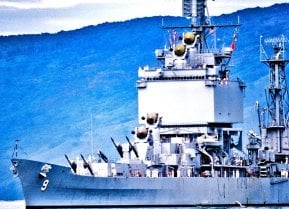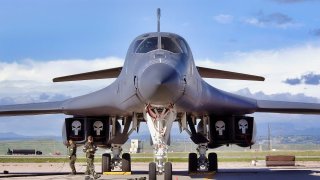B-1B vs. Tu-160: Unraveling the Myths Behind the World's Most Formidable Bombers
The U.S. Air Force's B-1B Lancer and the Soviet Union's Tu-160 Blackjack are among the largest and fastest bombers, showcasing a deceptive similarity at first glance.
Summary: The U.S. Air Force's B-1B Lancer and the Soviet Union's Tu-160 Blackjack are among the largest and fastest bombers, showcasing a deceptive similarity at first glance. Born from distinct design philosophies, the B-1B, envisioned in the 1960s, aimed to combine the B-52's range and payload with the B-58's speed, adjusting to the era's changing warfare landscape by adopting low-level penetration tactics to evade radar detection. The Tu-160, emerging in response to the B-1's revival in the 1980s, prioritizes high-speed, high-altitude operations, differing in its strategic focus and technological capabilities. Despite their initial roles, both bombers have adapted over time, with the B-1B transitioning towards a tactical support role and the Tu-160 undergoing modernization to bolster Russia's long-range capabilities.
Decoding the Giants of the Sky: The Evolution of the B-1B Lancer and Tu-160 Blackjack
The U.S. Air Force’s B-1B Lancer “Bone” and the Tu-160 “Blackjack” of Soviet manufacture are known for being some of the largest, fastest bombers ever.
At first glance, they appear nearly identical. Closer inspection, however, reveals that while the design considerations and technology available at the time of their creation meant they looked quite alike, the two aircraft were designed with different philosophies in mind.
Introducing the B-1B
The B-1B was conceived in the 1960s as an attempt to marry the range and payload of the B-52 with the speed of the B-58. Technology had improved throughout the 1950s, and the U.S. Air Force recognized that speed and altitude were no longer the only safe defense for strategic bombers.
Interceptor aircraft were long the only available tool able to attack bombers, and they could not match the high ceilings and top speeds of aircraft like the XB-70 Valkyrie. But then surface-to-air missiles (SAMs) were introduced. The shootdown of Gary Powers’ U-2 in 1960 by a SAM caused the Air Force to rethink its bombing doctrine, swapping high-altitude penetration for low-level ingress.
Flying at low level allows aircraft to take advantage of terrain masking. It breaks line of sight to the radar station, which struggles to get a return on the aircraft. Radar at the time was limited by ground clutter – false returns off of objects on the ground that rendered them useless below a certain elevation.
For aircraft like the Valkyrie that were optimized for high-altitude flight, though, operations in the thick air down low made them inefficient and ineffective.
The Department of Defense in the 1960s commissioned multiple studies on the feasibility and potential design of a low-altitude penetrator. Rockwell was awarded the B-1A development contract in 1970 and ultimately produced a variable-wing bomber capable of extended operations at low speeds, around Mach 0.85, but able to make a high-speed Mach 2.0 “dash” past Soviet defenses.
Work continued throughout the 1970s, but the B-1A was canceled in 1977 due to improvements in ballistic and cruise missiles, as well as the forthcoming B-2 Spirit stealth bomber, which rendered the B-1A obsolete.
In 1981, President Ronald Reagan revived the program. Returning as the B-1B, it was now intended to bridge the gap between the aging B-52 fleet and the B-2, which faced delays.
Introducing Russia's Tu-160 Bomber
Around the same time, the Soviet Union was finalizing plans for its supersonic strategic bomber. It too had begun work as early as the 1960s, but it was ultimately the revival of the B-1 program that prompted Soviet planners to begin production of the Tu-160.
Like the Bone, the Blackjack features variable geometry or “swing” wings, giving it better performance across the range of its flight envelope. It is much larger than its counterpart: 30 feet longer and with a takeoff weight 130,000 lbs greater.
Unlike the B-1B, the Tu-160 was never designed as a low-level bomber. Its top speed of Mach 2.0 far outstrips the Mach 1.25 of the B-1B, whose top speed was reduced as part of cost-cutting measures when the program was revived in the 1980s.
Furthermore, while it does have a greater takeoff weight, the Tu-160’s payload capability is less diverse, as it only has two bomb bays with rotating launcher racks. The Bone has three bomb bays as well as optional pylons. It can also be fitted with a sniper targeting pod for air support missions.
While the B-1B spent the 1990s and 2000s being modified into more of a support bomber, the Tu-160 has seen a revival of its own with the Tu-160M program. These bombers have upgraded airframes and avionics and give a major boost to the Russian long-range air fleet. Much as happened decades ago to the B-1B, the Tu-160M was approved in part as a stopgap measure until the PAK-DA stealth bomber is ready.
While the B-1B’s orientation changed over its lifetime toward more of a tactical support bombing role, advances in adversary air defenses mean it will most likely be limited to firing stand-off weapons and air-launched cruise missiles in any future conflict. In doing so, it will be carrying out the same mission as the Tu-160.
About the Author: Maya Carlin
Maya Carlin, National Security Writer with The National Interest, is an analyst with the Center for Security Policy and a former Anna Sobol Levy Fellow at IDC Herzliya in Israel. She has by-lines in many publications, including The National Interest, Jerusalem Post, and Times of Israel. You can follow her on Twitter: @MayaCarlin. Email the author: [email protected].


